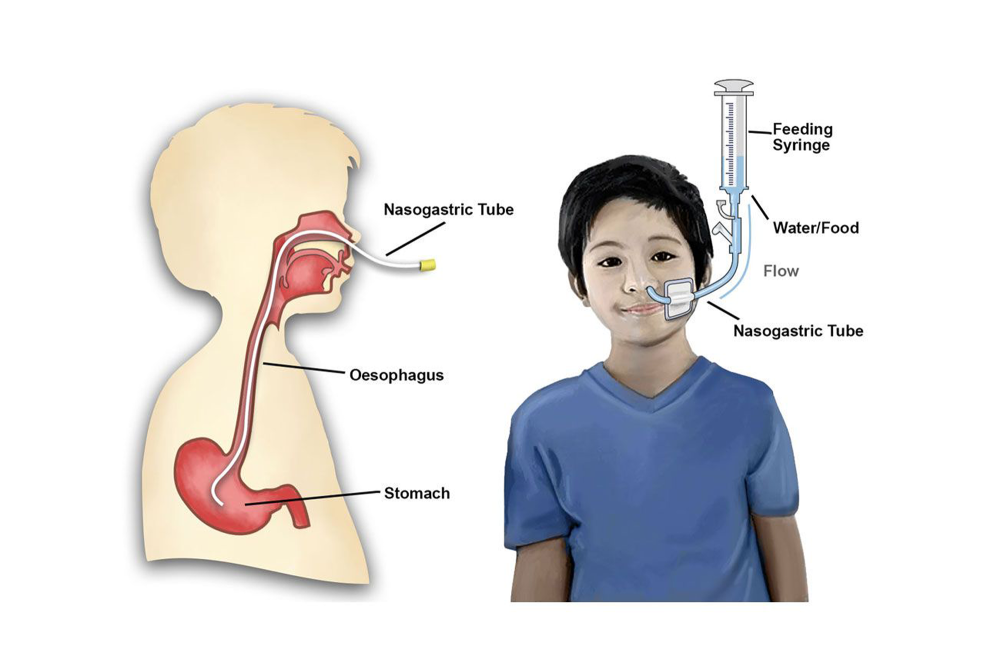What is a Nasogastric Tube?
A nasogastric (NG) tube is a thin, plastic tube that is inserted into one of your child's nostrils, down the back of the throat and into the stomach.
NG tubes are often used to feed children who cannot, for various reasons, eat and drink normally. While most children will require NG feeding for only a few days some require it for much longer and may even be discharged home with a NG tube.

What are the Advantages and Disadvantages of an NG Tube?
Advantages:
- Provides a safe method of feeding.
- Can be removed when not in use.
- No anesthetic is needed for insertion.
- Child may feel more comfortable because their stomach is filled as with normal feeding.
Disadvantages:
- Visible tubing.
- Insertion can sometimes cause distress, though is more comfortable once the tube is in place.
- Can be dangerous if inserted incorrectly.
- Can increase dripping nostrils especially when first inserted or if the child has a cold.
How is it Inserted?
Your nurse will insert your child's NG tube. The length and size of the tube needed depends on your child's size. Your nurse will first measure the correct length. Young infants or children will be wrapped in a blanket to stop them pulling at the tube as it is inserted. The nurse will insert the tube into your child's nostril. As the tube is passed down the back of the throat into the esophagus, the tube that carries food and liquid to your stomach, your child will be encouraged to swallow.
This may mean letting them suck on their thumb or if old enough take small sips of water. Once the tube has been passed to the required length it will be secured to your child's face with some adhesive tape. Inserting the tube does not hurt, but it is a new sensation and may be uncomfortable for a short while. It may also make your child sneeze, cough or gag as it tickles their throat. This passes once the tube is in place.
It is important to check that the NG tube is in the correct place, (the stomach). The esophagus and the airway separate from each other below the voice box and there is a small risk that the NG tube could end up in the airway instead of the stomach. If your nurse is concerned that the tube is not in the correct place, the tube will be removed immediately and replaced. Checking the position of the tube should occur on insertion as well as every time it is used. It is also important to check the tube position after periods of vomiting or a coughing episode as the tube can change its position.
Are There Any Risks or Complications with NG Tubes?
The main risk with inserting the NG tube is that you child may have a nosebleed when the tube is passed into the nostril as this area of tissue is sensitive. This is generally minor and stops without any serious intervention. As mentioned, there is also a risk that the tube could enter your child's windpipe instead of the esophagus and this is why it is important to check the tube position.
When Will I Be Taught How to Manage the NG Tube?
Many children require only short term feeding with an NG tube. If this is the case you will not be taught how to perform this task unless you particularly request to do so. For others who require this method of feeding for much longer your nurse will start to teach you how to look after the NG tube as soon as it has been inserted.
How Will My Child Feed Using the NG Tube?
Initially your child's feeding pattern and volume will be decided by your nurse. This plan will be discussed with your child's medical team. If feeding via the NG tube is going to be more long term your child will be referred to a dietician who will help develop a feeding plan that suits you and your child. There are three different methods of feeding your child using the NG tube—intermittent, continuous or a combination of both. For example, intermittent feeds during the day and a continuous feed overnight. You will be taught how to administer these feeds prior to you going home if necessary.
Some children require NG feeding although they are able to eat and drink normally, as they are unable to take sufficient quantities without supplementary feeding. Your nurse will be able to advise you if your child can have anything by mouth.
This information is for educational purposes only. It is not intended to replace the advice of your health care providers. If you have any questions, talk with your doctor or others on your health care team. If you are a Gillette patient with urgent questions or concerns, please contact Telehealth Nursing at 651-229-3890.
This information is for educational purposes only. It is not intended to replace the advice of your health care providers. If you have any questions, talk with your doctor or others on your health care team.
If you are a Gillette patient with urgent questions or concerns, please contact Telehealth Nursing at 651-229-3890.
 Home Page
Home Page
